Performance Analysis of Boosting Classifiers in Recognizing Activities of Daily Living
Abstract
1. Introduction
2. Overview of Boosting Algorithms and Their Use in Physical Activity Classification Research
2.1. Boosting Algorithms
2.1.1. Adaboost
2.1.2. Gradient Boosting
2.1.3. Lightgbm, Xgboost and Catboost
2.2. Use of Boosting Algorithms for PAC
2.3. Limitations In Existing Boosting-Based PAC Systems
- To provide an insight into existing boosting-based PAC systems and to provide the limitations and weaknesses of these systems in providing a fair and unbiased analysis.
- To provide a fair and unbiased performance comparison of boosting classifiers in profiling ADLs.
- To study the impact of feature selection on the performance of boosting classifiers and to identify which classifiers perform better than others with and without feature selection approach.
3. Materials and Methods
3.1. Dataset
3.2. Feature Set
3.3. Feature Selection
3.4. Classification and Cross-Validation
4. Result and Discussion
4.1. Overall Performance Analysis of Boosting Classifiers Used With and Without Feature Selection
4.1.1. Using All Feature Set
4.1.2. Using Reduced Feature Set
4.2. Performance Analysis of Individual ADL Classified by Boosting Classifiers
4.2.1. Using All Feature Set
4.2.2. Using Reduced Feature Set
4.3. Smartphone-Based Activity Profiling
5. Conclusions
Author Contributions
Funding
Conflicts of Interest
References
- World Health Organization. Global Recommendations on Physical Activity for Health; World Health Organization: Geneva, Switzerland, 2010. [Google Scholar]
- Gellert, P.; Wienert, J.; Ziegelmann, J.P.; Kuhlmey, A. Profiles of physical activity biographies in relation to life and aging satisfaction in older adults: Longitudinal findings. Eur. Rev. Aging Phys. 2019, 16, 221–226. [Google Scholar] [CrossRef] [PubMed]
- Daskalopoulou, C.; Stubbs, B.; Kralj, C.; Koukounari, A.; Prince, M.; Prina, A.M. Physical activity, and healthy ageing: A systematic review and meta-analysis of longitudinal cohort studies. Ageing Res. Rev. 2017, 38, 6–17. [Google Scholar] [CrossRef] [PubMed]
- Keadle, S.K.; McKinnon, R.; Graubard, B.I.; Troiano, R.P. Prevalence and trends in physical activity among older adults in the United States: A comparison across three national surveys. Prev. Med. 2016, 89, 37–43. [Google Scholar] [CrossRef]
- Morrill, A.C.; Chinn, C.D. The obesity epidemic in the United States. J. Public Health Policy 2004, 25, 353–366. [Google Scholar] [CrossRef] [PubMed]
- Johnson, J.A., 3rd; Johnson, A.M. Urban-rural differences in childhood and adolescent obesity in the United States: A systematic review and meta-analysis. Child. Obes. 2015, 11, 233–241. [Google Scholar] [CrossRef] [PubMed]
- Lobstein, T.; Jackson-Leach, R.; Moodie, M.L.; Hall, K.D.; Gortmaker, S.L.; Swinburn, B.A.; James, W.P.T.; Wang, Y. Child and adolescent obesity: Part of a bigger picture. Lancet 2015, 385, 2510–2520. [Google Scholar] [CrossRef]
- DeNicola, E.; Aburizaiza, O.S.; Siddique, A.; Khwaja, H.; Carpenter, D.O. Obesity and public health in the Kingdom of Saudi Arabia. Rev. Environ. Health 2015, 30, 191–205. [Google Scholar] [CrossRef]
- Memish, Z.A.; El Bcheraoui, C.; Tuffaha, M.; Robinson, M.; Daoud, F.; Jaber, S.; Mikhitarian, S.; Al Saeedi, M.; AlMazroa, M.A.; Mokdad, A.H.; et al. Obesity and Associated Factors—Kingdom of Saudi Arabia, 2013. Prev. Chronic Dis. 2014, 11, E174. [Google Scholar] [CrossRef]
- Al-Hazzaa, H.M.; Abahussain, N.A.; Al-Sobayel, H.I.; Qahwaji, D.M.; Alsulaiman, N.A.; Musaiger, A.O. Prevalence of overweight, obesity, and abdominal obesity among Urban Saudi adolescents: Gender and regional variations. J. Health Popul. Nutr. 2014, 32, 634–645. [Google Scholar]
- Azzeh, F.S.; Bukhari, H.M.; Header, E.A.; Ghabashi, M.A.; Al-Mashi, S.S.; Noorwali, N.M. Trends in overweight or obesity and other anthropometric indices in adults aged 18-60 years in Western Saudi Arabia. Ann. Saudi Med. 2017, 37, 106–113. [Google Scholar] [CrossRef]
- Engin, A. The definition and prevalence of obesity and metabolic syndrome. Adv. Exp. Med. Biol. 2017, 960, 1–17. [Google Scholar] [PubMed]
- Ng, S.W.; Zaghloul, S.; Ali, H.; Harrison, G.; Popkin, P.M. The prevalence and trends of overweight, obesity and nutrition-related non-communicable diseases in the Arabian Gulf States. Obes. Res. 2011, 12, 1–13. [Google Scholar] [CrossRef] [PubMed]
- Hamam, F.A.; Eldalo, A.S.; Alnofeie, A.A.; Alghamdi, W.Y.; Almutairi, S.S.; Badyan, F.S. The association of eating habits and lifestyle with overweight and obesity among health sciences students in Taif University, KSA. J. Taibah Univ. Med Sci. 2017, 12, 249–260. [Google Scholar] [CrossRef] [PubMed]
- Raza, M.; Awais, M.; Ellahi, W.; Aslam, N.; Nguyen, H.X.; Le-Minh, H. Diagnosis and Monitoring of Alzheimer’s Patients Using Classical and Deep Learning Techniques. Expert Syst. Appl. 2019, 136, 353–364. [Google Scholar] [CrossRef]
- Alphen, H.J.V.; Hortobagyi, T.; Heuvelen, M.J.V. Barriers, motivators, and facilitators of physical activity in dementia patients: A systematic review. Arch. Gerontol. Geriatr. 2016, 66, 109–118. [Google Scholar] [CrossRef]
- Blankevoort, C.G.; Van Heuvelen, M.J.; Boersma, F.; Luning, H.; De Jong, J.; Scherder, E.J. Review of effects of physical activity on strength, balance, mobility and ADL performance in elderly subjects with dementia. Dement. Geriatr. Cogn. Disord. 2010, 30, 392–402. [Google Scholar] [CrossRef]
- Burns, J.M.; Mayo, M.S.; Anderson, H.S.; Smith, H.J.; Donnelly, J.E. Cardiorespiratory fitness in early-stage Alzheimer disease. Alzheimer Dis. Assoc. Disord. 2008, 22, 39–46. [Google Scholar] [CrossRef]
- Cedervall, Y.; Åberg, A.C. Physical activity and implications on well-being in mild Alzheimer’s disease: A qualitative case study on two men with dementia and their spouses. Physiother. Theory Pract. 2010, 26, 226–239. [Google Scholar] [CrossRef]
- Friedman, J.H. Stochastic gradient boosting. Comput. Stat. Data Anal. 2002, 38, 367–378. [Google Scholar] [CrossRef]
- Ke, G.; Meng, Q.; Finley, T.; Wang, T.; Chen, W.; Ma, W.; Ye, Q.; Liu, T.Y. LightGBM: A Highly Efficient Gradient Boosting Decision Tree. In Proceedings of the 31st Conference on Neural Information Processing Systems, Long Beach, CA, USA, 4 December 2017. [Google Scholar]
- Chen, T.; Guestrin, C. XGBoost: A Scalable Tree Boosting System. In Proceedings of the 22nd ACM Sigkdd International Conference on Knowledge Discovery and Data Mining, San Francisco, CA, USA, 13–17 August 2016. [Google Scholar]
- Prokhorenkova, L.; Gusev, G.; Vorobev, A.; Dorogush, A.V.; Gulin, A. CatBoost: Unbiased boosting with categorical features. In Proceedings of the 32nd International Conference on Neural Information Processing Systems, Montréal, QC, Canada, 3–8 December 2018; pp. 6639–6649. [Google Scholar]
- Fisher, W.D. On Grouping for Maximum Homogeneity. J. Am. Stat. Assoc. 1958, 53, 789–798. [Google Scholar] [CrossRef]
- Li, P.; Wang, Y.; Tian, Y.; Zhou, T.S.; Li, J.S. An Automatic User-Adapted Physical Activity Classification Method Using Smartphones. IEEE Trans. Biomed. Eng. 2017, 64, 706–714. [Google Scholar] [CrossRef] [PubMed]
- Zubair, M.; Song, K.; Yoon, C. Human activity recognition using wearable accelerometer sensors. In Proceedings of the 2016 IEEE International Conference on Consumer Electronics-Asia, Seoul, South Korea, 26–28 October 2016; pp. 1–5. [Google Scholar]
- Ugulino, W.; Cardador, D.; Vega, K.; Velloso, E.; Milidiú, R.; Fuks, H. Wearable Computing: Accelerometers’ Data Classification of Body Postures and Movements. In Proceedings of the 21st Brazilian Symposium on Artificial Intelligence Conference on Advances in Artificial Intelligence-SBIA 2012, Curitiba, Brazil, 20–25 October 2012; Springer: Berlin/Heidelberg, Germany, 2012; pp. 52–61. [Google Scholar]
- Reiss, A.; Stricker, D.; Hendeby, G. confidence-based multiclass AdaBoost for physical activity monitoring. In Proceedings of the 17th Annual International Symposium on International Symposium on Wearable Computers, Zurich, Switzerland, 8–12 September 2013; pp. 13–20. [Google Scholar]
- Asuncion, A.; Newman, D.J. UCI Machine Learning Repository; University of California, Irvine, School of Information and Computer Science: Irvine, CA, USA, 2007; Available online: http://archive.ics.uci.edu/ml/index.php (accessed on 2 October 2019).
- Lee, K.; Kwan, M.P. Physical activity classification in free-living conditions using smartphone accelerometer data and exploration of predicted results. Comput. Environ. Urban Syst. 2018, 67, 124–131. [Google Scholar] [CrossRef]
- Esseiva, J.; Caon, J.; Mugellini, E.; Khaled, O.A.; Aminian, K. Feet fidgeting detection based on accelerometers using decision tree learning and gradient boosting. In Proceedings of the International Conference on Bioinformatics and Biomedical Engineering, Kunming, China, 15–17 September 2018; Springer: Berlin/Heidelberg, Germany, 2018; pp. 75–84. [Google Scholar]
- Guo, J.; Yang, L.; Bie, R.; Yu, J.; Gao, Y.; Shen, Y.; Kos, A. An XGBoost-based physical fitness evaluation model using advanced feature selection and Bayesian hyper-parameter optimization for wearable running monitoring. Comput. Netw. 2019, 151, 166–180. [Google Scholar] [CrossRef]
- Zhang, W.; Zhao, X.; Li, Z. A Comprehensive Study of Smartphone-Based Indoor Activity Recognition via Xgboost. IEEE Access 2019, 7, 80027–80042. [Google Scholar] [CrossRef]
- Gao, X.; Luo, H.; Wang, Q.; Zhao, F.; Ye, L.; Zhang, Y. A Human Activity Recognition Algorithm Based on Stacking Denoising Autoencoder and LightGBM. Sensors 2019, 19, 947. [Google Scholar] [CrossRef]
- Awais, M.; Palmerini, L.; Bourke, A.K.; Ihlen, E.A.; Helbostad, J.L.; Chiari, L. Performance Evaluation of State of the Art Systems for Physical Activity Classification of Older Subjects Using Inertial Sensors in a Real-Life Scenario: A Benchmark Study. Sensors 2016, 16, 2105. [Google Scholar] [CrossRef]
- Anguita, D.; Ghio, A.; Oneto, L.; Parra, X.; Reyes-Ortiz, J.L. A Public Domain Dataset for Human Activity Recognition Using Smartphones. In Proceedings of the European Symposium on Artificial Neural Networks, Bruges, Belgium, 24–26 April 2013; pp. 24–26. [Google Scholar]
- Awais, M.; Chiari, L.; Ihlen, E.A.; Helbostad, J.L.; Palmerini, L. Physical Activity Classification for Elderly People in Free-Living Conditions. IEEE J. Biomed. Health Inform. 2019, 23, 197–207. [Google Scholar] [CrossRef]
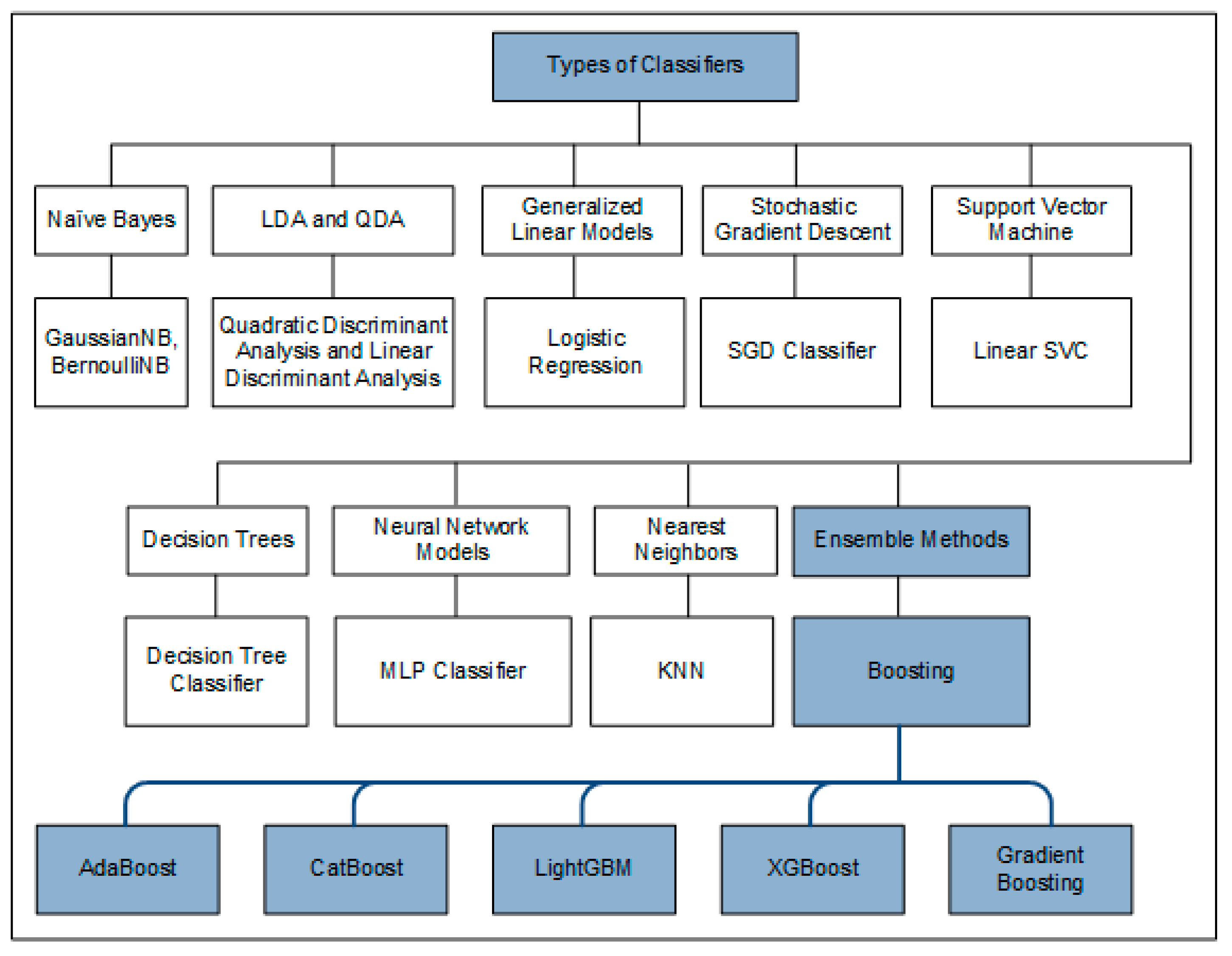
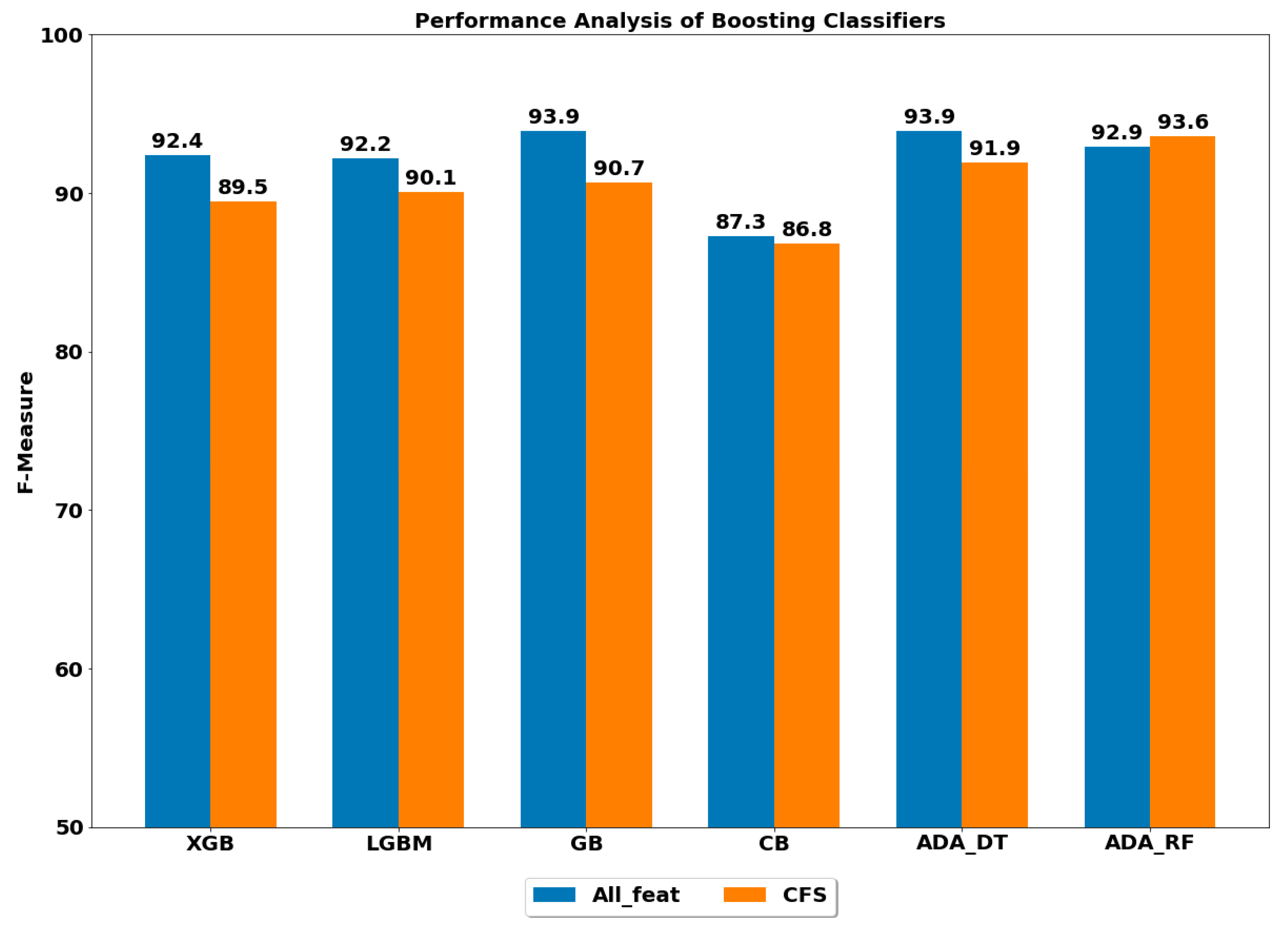
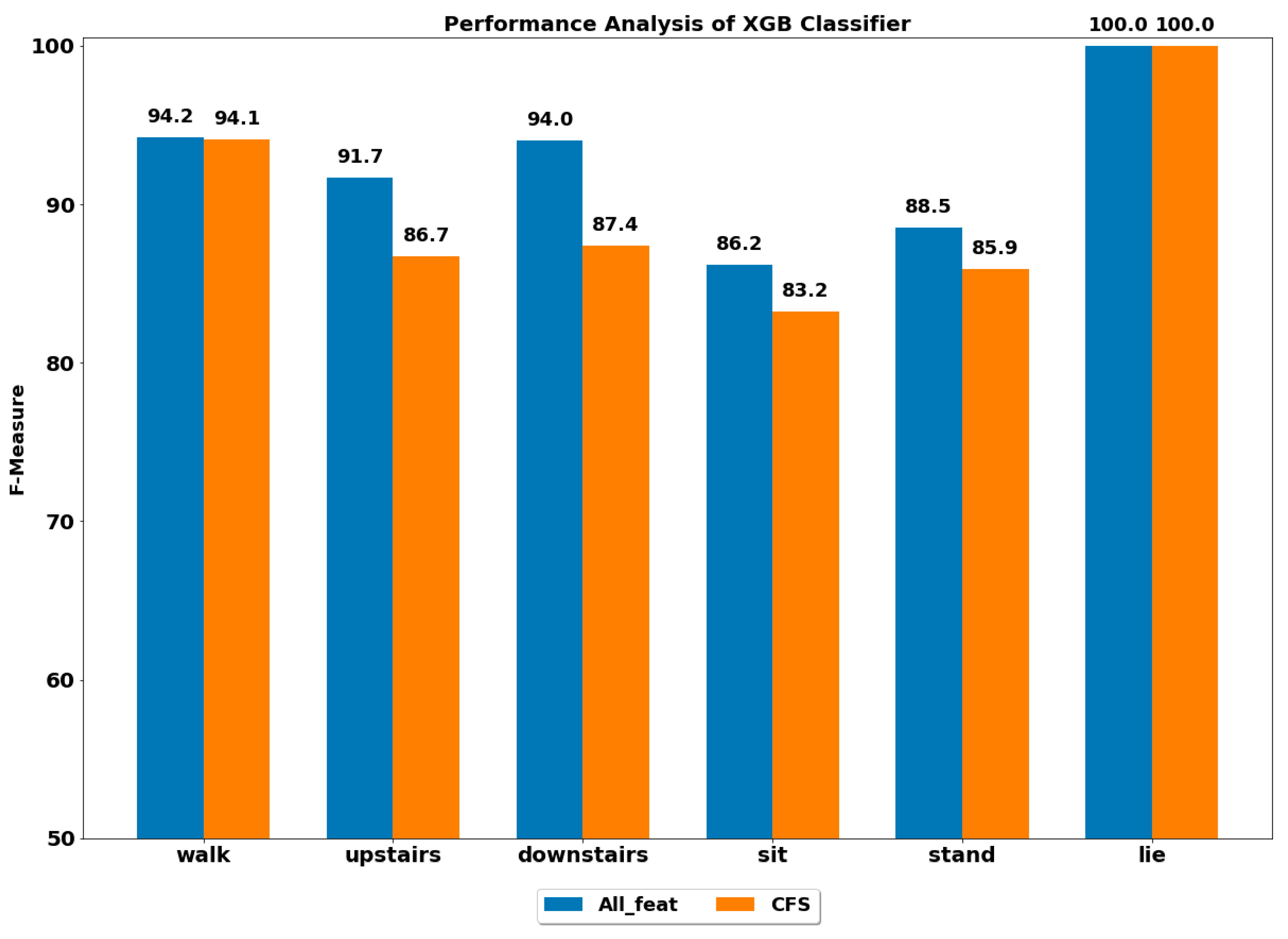
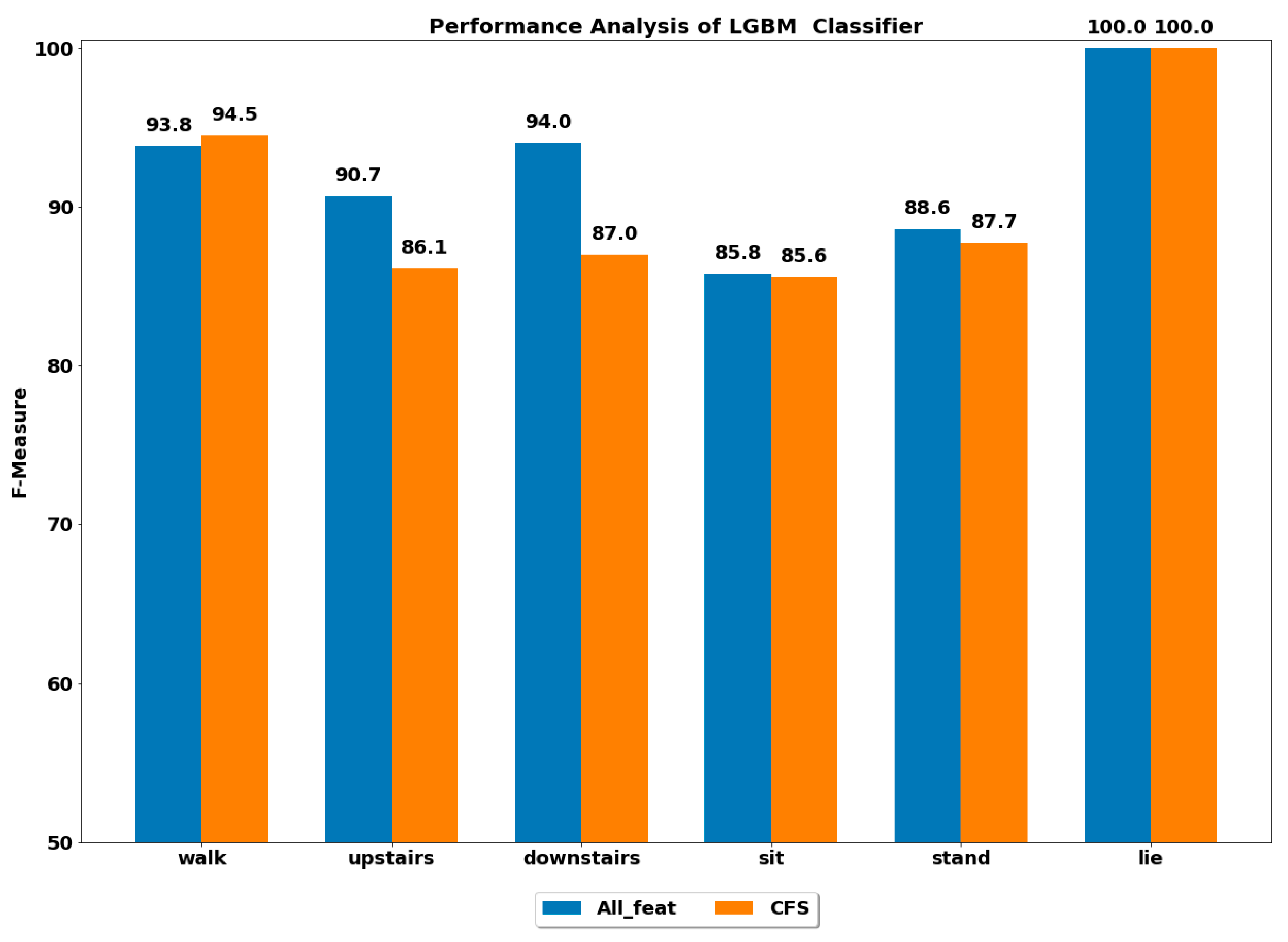
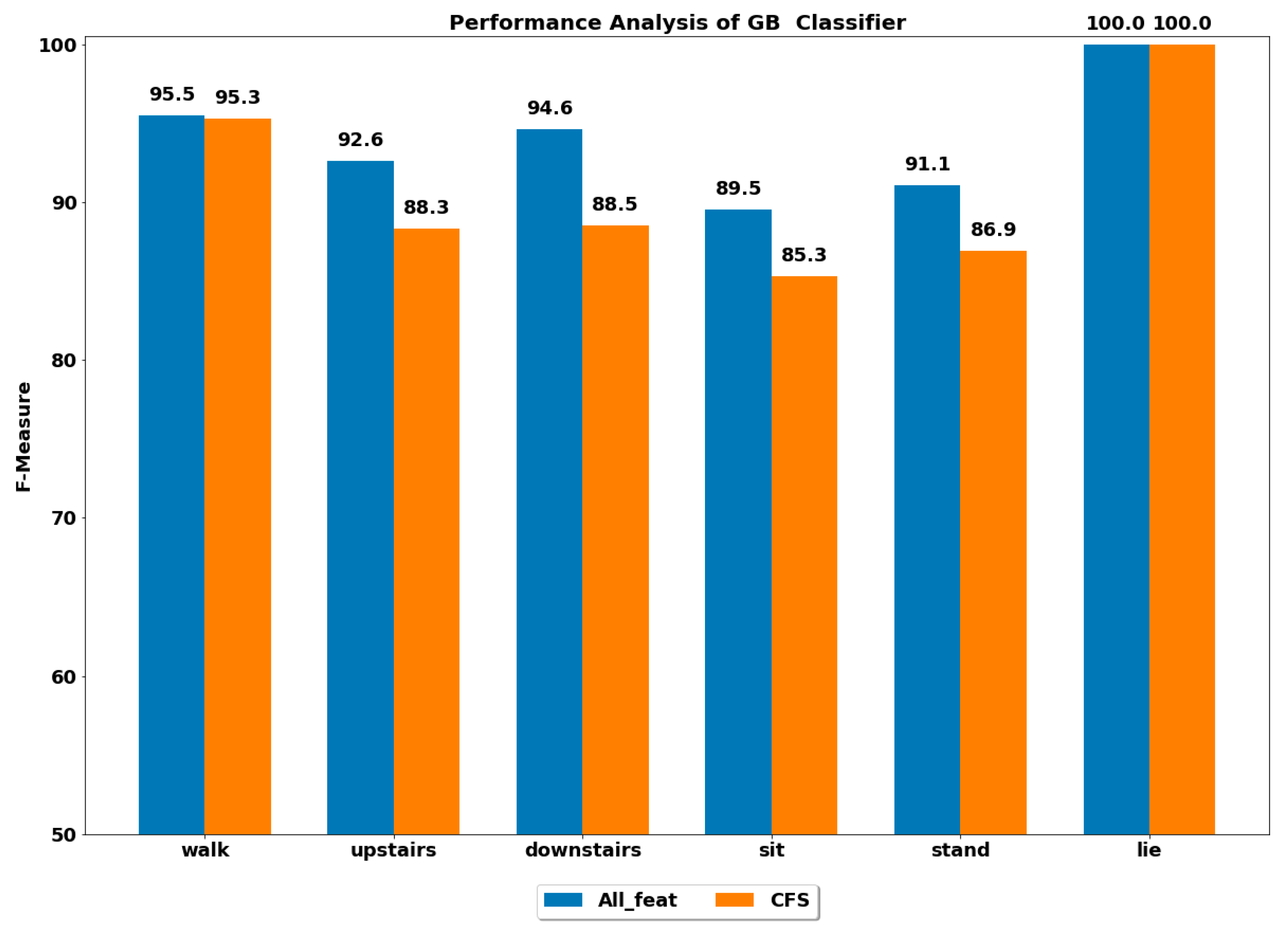
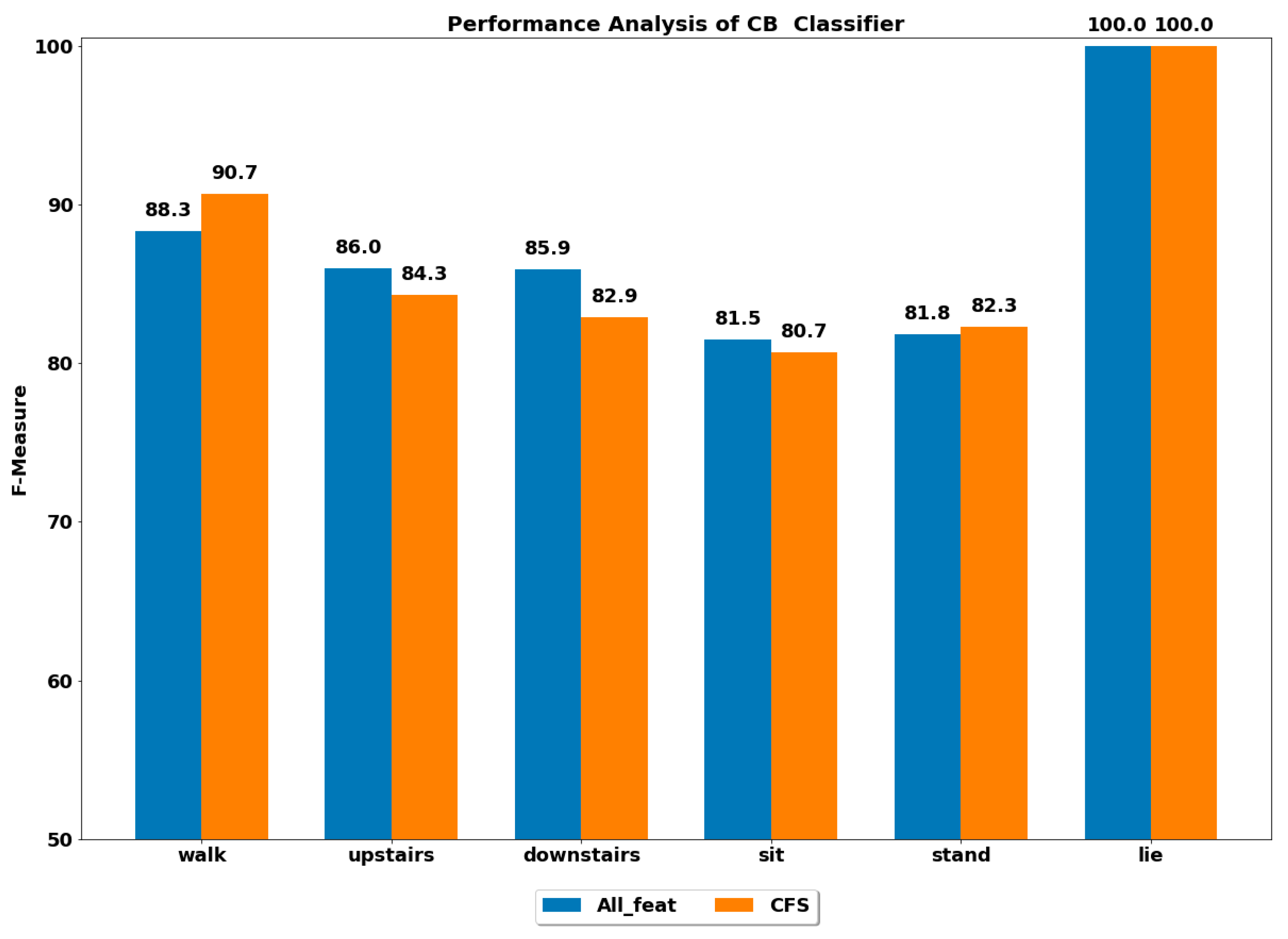
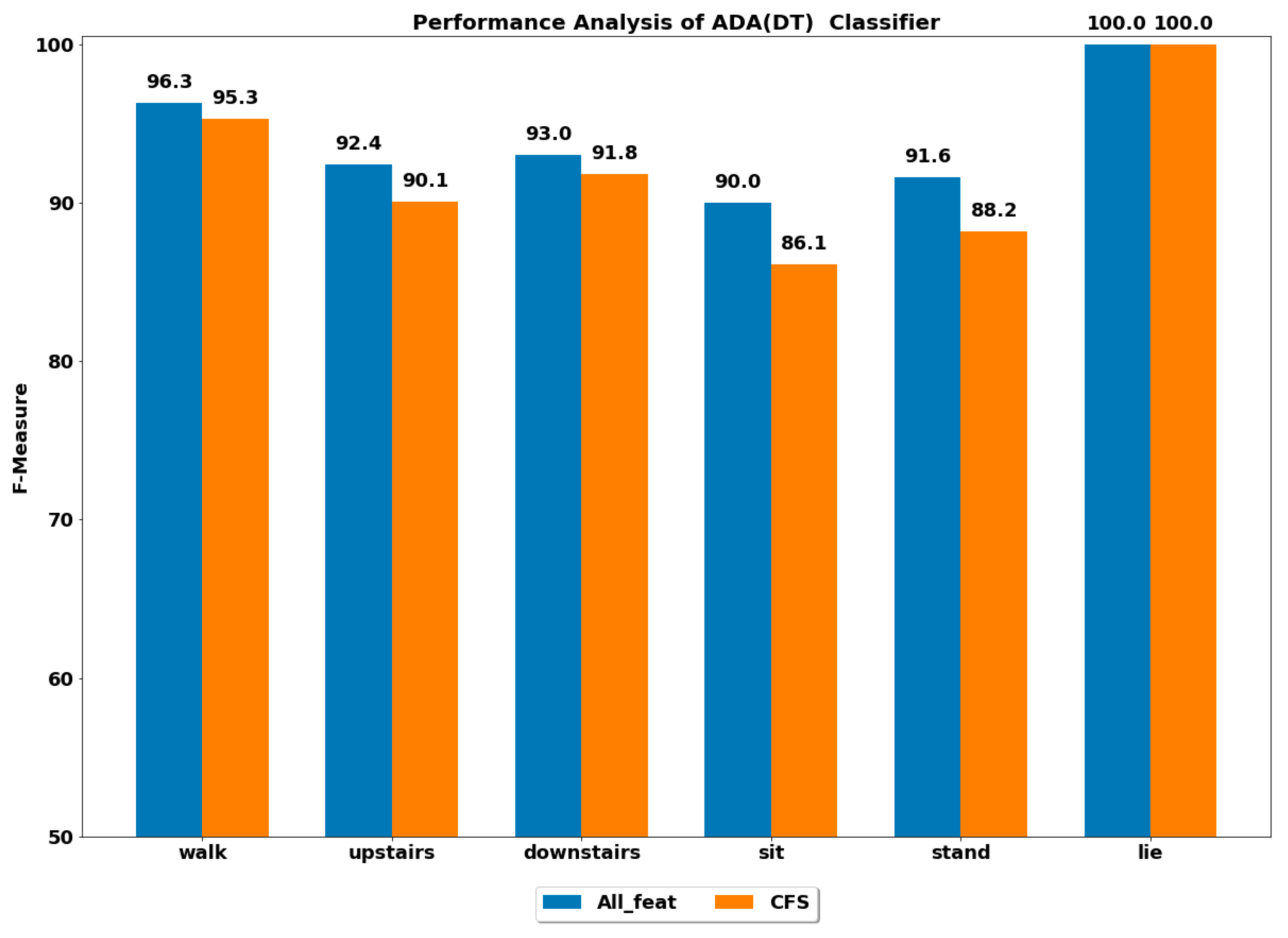
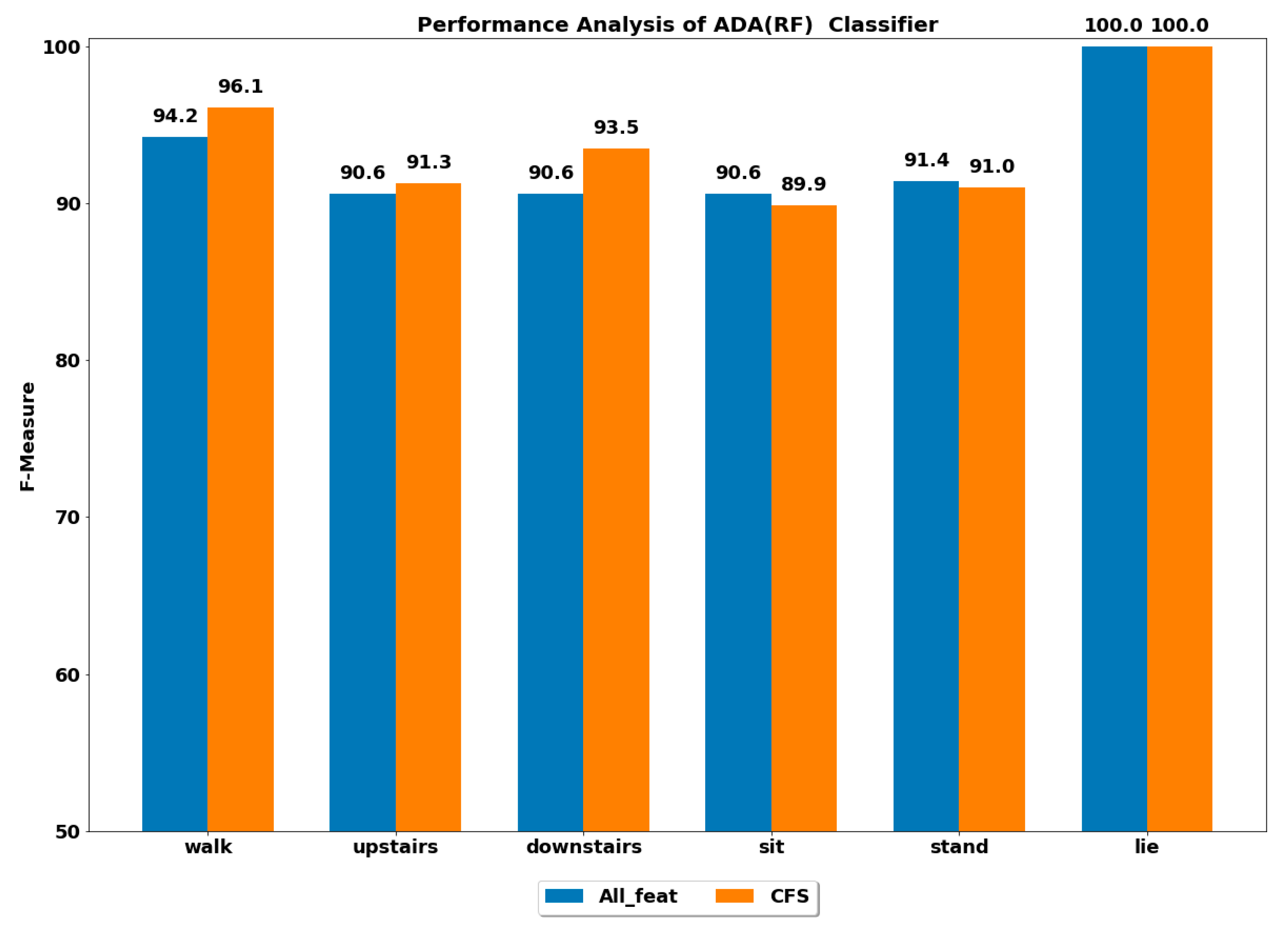
| Author | Sensor | Activities | Classifiers | Metrics | Result |
|---|---|---|---|---|---|
| Li et al. [25] | Gyroscopes, acceleration sensors | Walking, sitting, standing, cycling and running | Adaboost (base classifier), Decision Tree (weak learner) | Accuracy | 98% |
| Zubair et al. [26] | Accelerometer | Standing up, standing, sitting down, sitting and walking | Adaboost (Decision Tree, Random Forest) | Accuracy | 99.9% Accuracy of Adaboost |
| Reiss et al. [28] | Accelerometer | Descending and ascending stairs, walking, cycling, running, standing, sitting and laying | Adaboost | Accuracy | 77.78% |
| Lee et al. [30] | Smartphones | Standing, sitting, downstairs, upstairs, jogging and walking | Gradient boosting, Random Forests | Accuracy | 99.03% 99.22% |
| Esseiva et al. [31] | Accelerometers | Four positions of the leg for feet fidgeting; upper leg swinging, up and down leg bouncing, lower leg swinging, foot jiggling | Gradient boosting, Adaboost, random forest and decision tree | Accuracy, precision, recall, F-score | 95% accuracy for gradient boosting |
| Guo et al. [32] | Smart bands | Four levels of fitness; excellent, good, medium, poor | XGBoost, | F-measure | 99% for XGBoost |
| Zhang et al. [33] | Barometer, gyroscope and accelerometer | Elevator taking, stair climbing, stillness, escalator taking and walking | XGBoost, | F-measure | 84.19% for XGBoost |
| Gao et al. [34] | Accelerometer, gyroscope, magnetic and pressure sensor | Static mode, dynamic mode and moving mode | SDAE with LightGBM | Accuracy | 95.99% |
| Activity Type | Total Dataset | Percentage (Total Dataset) | Train Split | Test Split |
|---|---|---|---|---|
| Walk | 1722 | 16.72% | 1226 | 496 |
| Upstairs | 1544 | 14.99% | 1073 | 471 |
| Downstairs | 1406 | 13.65% | 986 | 420 |
| Sit | 1777 | 17.25% | 1286 | 491 |
| Stand | 1906 | 18.51% | 1374 | 532 |
| Lie | 1944 | 18.88% | 1407 | 537 |
| Predicted | Walk | Upstairs | Downstairs | Sit | Stand | Lie | |
|---|---|---|---|---|---|---|---|
| Actual | |||||||
| Walk | 486 | 6 | 4 | 0 | 0 | 0 | |
| Upstairs | 29 | 435 | 6 | 1 | 0 | 0 | |
| Downstairs | 7 | 26 | 386 | 0 | 1 | 0 | |
| Sit | 0 | 2 | 0 | 424 | 65 | 0 | |
| Stand | 0 | 0 | 0 | 32 | 500 | 0 | |
| Lie | 0 | 0 | 0 | 0 | 0 | 537 | |
| Predicted | Walk | Up-Stairs | Down-Stairs | Sit | Stand | Lie | |
|---|---|---|---|---|---|---|---|
| Actual | |||||||
| Walk | 491 | 1 | 4 | 0 | 0 | 0 | |
| Upstairs | 33 | 428 | 10 | 0 | 0 | 0 | |
| Downstairs | 2 | 37 | 381 | 0 | 0 | 0 | |
| Sit | 0 | 1 | 0 | 436 | 54 | 0 | |
| Stand | 0 | 0 | 0 | 43 | 489 | 0 | |
| Lie | 0 | 0 | 0 | 0 | 0 | 537 | |
© 2020 by the authors. Licensee MDPI, Basel, Switzerland. This article is an open access article distributed under the terms and conditions of the Creative Commons Attribution (CC BY) license (http://creativecommons.org/licenses/by/4.0/).
Share and Cite
Rahman, S.; Irfan, M.; Raza, M.; Moyeezullah Ghori, K.; Yaqoob, S.; Awais, M. Performance Analysis of Boosting Classifiers in Recognizing Activities of Daily Living. Int. J. Environ. Res. Public Health 2020, 17, 1082. https://doi.org/10.3390/ijerph17031082
Rahman S, Irfan M, Raza M, Moyeezullah Ghori K, Yaqoob S, Awais M. Performance Analysis of Boosting Classifiers in Recognizing Activities of Daily Living. International Journal of Environmental Research and Public Health. 2020; 17(3):1082. https://doi.org/10.3390/ijerph17031082
Chicago/Turabian StyleRahman, Saifur, Muhammad Irfan, Mohsin Raza, Khawaja Moyeezullah Ghori, Shumayla Yaqoob, and Muhammad Awais. 2020. "Performance Analysis of Boosting Classifiers in Recognizing Activities of Daily Living" International Journal of Environmental Research and Public Health 17, no. 3: 1082. https://doi.org/10.3390/ijerph17031082
APA StyleRahman, S., Irfan, M., Raza, M., Moyeezullah Ghori, K., Yaqoob, S., & Awais, M. (2020). Performance Analysis of Boosting Classifiers in Recognizing Activities of Daily Living. International Journal of Environmental Research and Public Health, 17(3), 1082. https://doi.org/10.3390/ijerph17031082






